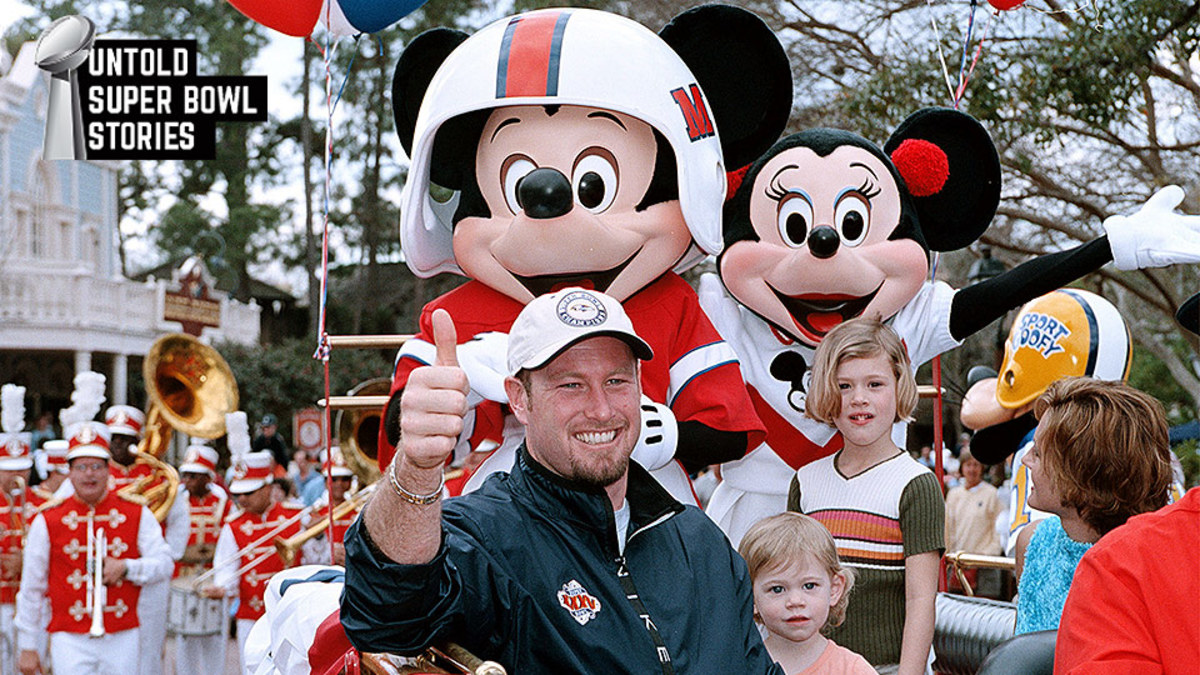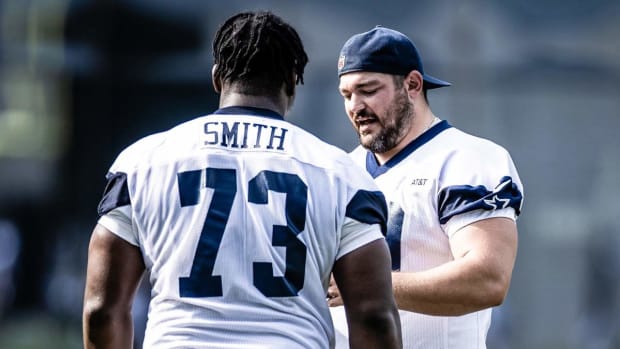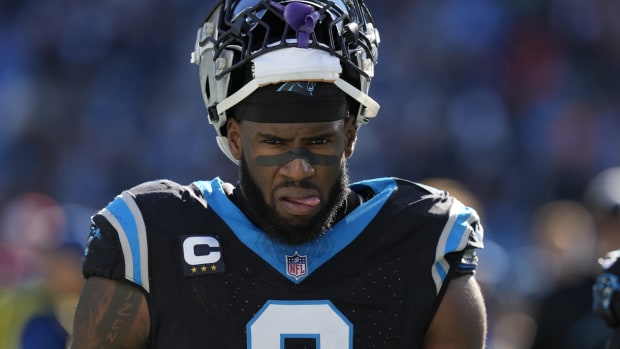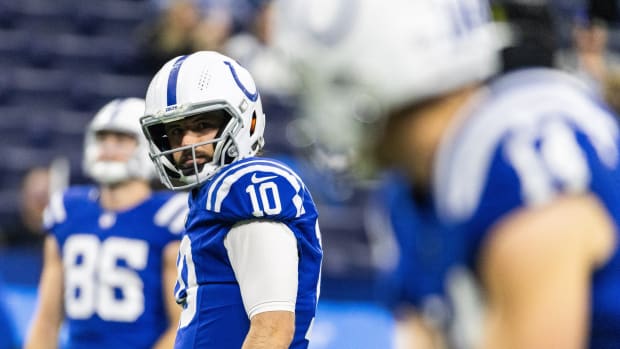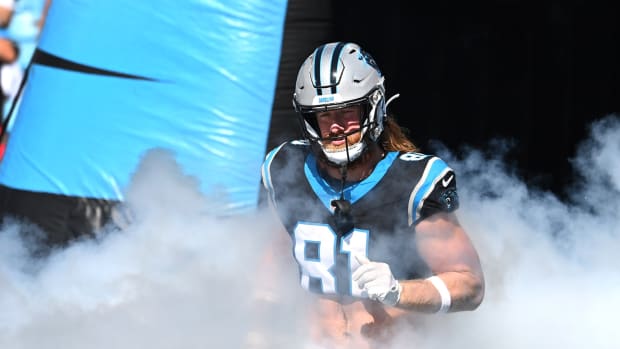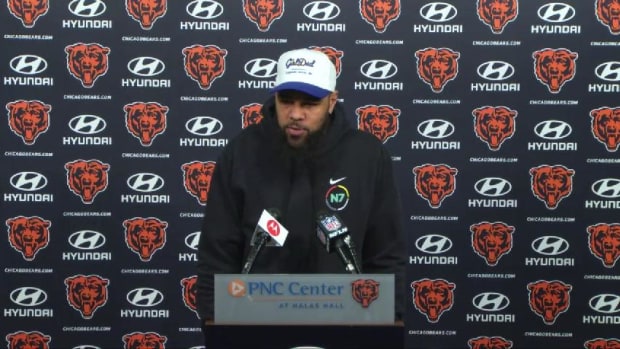'I'm going to Disneyland!' How simple phrase became Super Bowl lore
As part of our countdown to Super Bowl 50, SI.com is rolling out a series focusing on the overlooked, forgotten or just plain strange history of football's biggest game. From commercials to Super Bowl parties, we'll cover it all, with new stories published every Wednesday here.
Last January, Derek Simpson, a personal injury lawyer based in Huntsville, Ala., received an unexpected phone call. Simpson had recently become certified as an NFL agent, and he had exactly one client at the time. So far that year he had watched as his client went undrafted, he helped the client sign a free-agent contract, and he celebrated as his player made a 53-man roster. Now, inexplicably, that player was on a team that was competing in the Super Bowl. “It was a year of firsts,” says Simpson. “But then someone called and asked if my client would agree to be in a commercial if he happened to play well in the big game.”
Simpson laughed. His client was a reserve cornerback, a once-cut JUCO player who two years earlier was working a $7.25-an-hour job at Popeyes. Right. Like he would be the star of Super Bowl XLIX.
Malcolm Butler was hesitant, too. It’s not that he didn’t believe in himself; the odds were just too. ... No way. Simpson nagged, though, and Butler signed the document six days before the game.
Butler, of course, claimed a place in Patriots lore by intercepting Seahawks quarterback Russell Wilson in the end zone to seal New England’s shocking 28-24 comeback win in Super Bowl XLIX. A few hours later, the morning TV shows all played a familiar commercial:
A theatrical voice belts out “When You Wish Upon a Star” over clips of the Patriots’ biggest plays until a sprightly voice jumps in. “Malcolm Butler and Julian Edelman (as in the teammate who caught the winning TD), you and the New England Patriots just won the Super Bowl! What are you going to do next?” Edelman and Butler mug for the camera: “We’re going to Disneyland!”
Bud Bowl: The novel idea that forever changed Super Bowl commercials
Disney’s “What’s Next” commercial has become as much a Super Bowl fixture as office-pool squares and guacamole; it instantly evokes elation, athletic achievement and, in cases like Butler’s, fairy tale endings. It’s such a part of the lexicon in American pop culture that when the titular character on the sitcom Ellen came out as gay in 1997 and her TV therapist asked what she would do next, Ellen DeGeneres, in character, responded without hesitation, “I’m going to Disneyland!”
As a commercial, it’s simple and pure. And still: The logistics are complicated, the roots inconspicuous. SI asked those who helped shape the cultural phenomenon to help tell the messy story.
MICHAEL EISNER (Disney CEO, 1984-2005): In January 1987, we were launching Disneyland’s Star Tours, an attraction based on Star Wars. After the ribbon-cutting ceremony, my wife, Jane, and I had dinner with George Lucas, as well as Dick Rutan and Jeana Yeager, who had just become the first people to fly around the world without stopping. It was late and the conversation hit a lull as we waited for our food. So I asked Dick and Jeana, “Well, now that you’ve accomplished the pinnacle of your aspirations, what could you possibly do next?” Rutan responded, without hesitation, “I’m going to Disneyland.” And of course I go, “Wow, that’s cool! You made the right choice.” But my wife interjects: “You know, that’s a good slogan.”
Two days later the Giants defeated the Redskins in the NFC Championship Game and the Broncos beat the Browns in the AFC to set up their meeting in Super Bowl XXI, on Jan. 25 at the Rose Bowl.
EISNER: I became obsessed with the idea. It was as organic a campaign as there is: no flip cards, no agencies. If you reached the pinnacle of your life or career, what reward would you give yourself? I instantly thought of the Super Bowl; it would be the perfect debut. We would have a crew on the field to film the second the game ended; the place would be going crazy, teammates high-fiving in the background, confetti falling.
TOM ELROD (Disney President of Marketing and Entertainment, 1973-88): We wanted it to be authentic, but that meant being the first camera on the field, in the most frenetic environment you could possibly imagine. We’d be competing with broadcast crews and journalists and hangers-on and teammates, just to have some guy look into a camera and say, “I’m going to Disney World.” It’s wild if you think about it. That first year, I don’t think anyone thought that was achievable.
EISNER: I called up [then commissioner] Pete Rozelle and he was very cooperative.
ELROD: I think the NFL saw our vision. That was huge. We also had a good relationship with them from producing the halftime shows.
EISNER: We would give the NFL money, but we wouldn’t give the players a lot of money. Not because we were cheap; we just wanted it to be clean. This was about the aspiration of going to Disney, not buying a celebrity endorsement. So we identified likely MVPs, players from each team, and we tried to make a deal. In the end we settled on the quarterbacks: Phil Simms and John Elway.
PHIL SIMMS (Giants quarterback, 1979-93; Super Bowl XXI MVP): A few days before the game, my agent calls me up and explains the deal. I said, “No—absolutely not. I want no part of that.” To agree to something like this before the game was even played? That just seemed like a distraction I didn’t want.
EISNER: We needed the players on board. If we didn’t have them, there’s no way we could execute it. The TV spot needed to be cut that night and ready for all the major morning shows: Good Morning America, The Today Show. ...
SIMMS: My agent called again. He said they’d guarantee me money whether I won or lost. That didn’t really matter to me, but my agent wanted me to do it so finally I just gave in.
Simms was paid $75,000. Various reports suggest that Elway (five years his junior) made somewhere between $15,000 and $75,000.
MARK CHAMPION (Broadcaster, now doing play-by-play for the Pistons): I was the voice of the Buccaneers at the time. A college classmate of mine was a marketing director at Disney. He called me out of the blue and asked if I would be interested in voicing a commercial. Of course I was. I thought it would be a one-time shoot and then over with—I’d never hear about it again.
The Giants won Super Bowl XXI 39-20 behind Simms, the MVP, who passed for 268 yards and three touchdowns.
SIMMS: I’m on the field—celebrating, soaking in the moment—and I feel a tap on my shoulder. “Disney!” the guy says. I’d totally forgotten. I’m like, “Are you kidding me? We have to do this now?” But OK, I do it. I say the lines just like they asked.
EISNER: Looking at the footage, it was the ideal image. It provided an emotional connection. It was wholesome, it was perfect ...
SIMMS: It was weird. The next couple weeks, people congratulated me on the game—but I heard from just as many people who said, “I loved your commercial!”
BRAD JOHNSON (NFL quarterback, 1992-2008): I was a senior in high school during that Super Bowl; of course I remember the commercial. I thought it was awesome. I used to practice the lines in my mirror—“I’m going to Disney World. I’m going to Disneyland”—just dreaming that one year it could be me.
EISNER: Once it was established, everyone wanted to do it. After the Super Bowl we tried it for the World Series.
FRANK VIOLA (MLB pitcher, 1982-96; ‘87 World Series MVP with the Twins): It was after the eighth inning of Game 7 [against the Cardinals] and I was told I wasn’t going to be going out for the ninth. A couple people from the TV network came up to me and said, “If you guys happen to win, I need you to say, ‘I’m going to Disney World! I’m going to Disneyland!’ I was like, jeez, I must be in the running for MVP! [A commercial] was the last thing on my mind, but I had seen the one with Phil Simms and thought it was cool, so here it goes. ...
ELROD: To pull off that first commercial with Phil Simms was a big scramble, and I don’t know that it has become any easier since. The negotiations are never easy. Agents try to cut as tough a deal as they can. Over time, many of them realized it could be a prestigious opportunity, and so we usually got it done.
DOUG WILLIAMS (NFL quarterback, 1978-82, ‘86-89; Super Bowl XXII MVP with the Redskins): [My commercial contract] was negotiated a couple days before the Super Bowl, and for me it was a big deal. A lot was made about my race before that game, and to do a big national spot like this? The thing is, this ad had nothing to do with race, it was just about the pure joy of celebration and athletic achievement.
The scabs who paved the way for the Redskins’ 1987 Super Bowl title
EISNER: I heard that Warner Bros. tried doing the same thing with a movie. Their campaign was going to be, “Now that you’ve reached this level of excellence, what are you going to do?” And the person would say, “I’m going to see some movie!” I can’t remember what movie it was but I went completely nuts. I told Warner Bros., “That’s ours; you’d better stay away.” I don’t know if we had a copyright, per se, but we had so ingratiated ourselves with America. We convinced Warner Bros. to back off. This was a Disney thing.
GRETCHEN CARLSON (1989 Miss America; current Fox News anchor): In Atlantic City, preparing for the pageant, we actually practiced the Disney line. But when I was crowned the winner I totally forgot. I took my walk down the aisle and I heard people yelling at me, “Disney!” I was like, “What?” And then, “Oh yeah, OK.” I looked into the camera and said, “I’m going to Disney World!” I started walking back to the other contestants; I made it halfway down the runway before I was interrupted again. They wanted me to do it a second time. Then again. And again. I guess they wanted the right shot. If you watch through the credits of that broadcast you’ll see the film still rolling while I walk up and down the aisle a few more times.
EISNER: Once the campaign became successful we used it in the NBA Finals, at the Olympics, college graduations. ... But the Super Bowl was always at its core. I’m not sure why it hasn’t stuck for other sports. Maybe it’s a budgetary thing because the commercial is expensive to put on.
REGGIE WILLIAMS (Bengals linebacker, 1976-89; Disney Vice President for Sports Attractions, 1997-2007): By the time we were in Super Bowl XXIII, we all knew the commercial. It had become a big deal, and something they began mobilizing on the sideline. In the fourth quarter [when Cincinnati led San Francisco 16-13, with just over three minutes remaining] I guess they were going to give it to Boomer [Esiason] because the camera crew was huddling around him. He was practicing his lines. Then all of a sudden, they vanished.
Joe Montana’s touchdown pass to San Francisco receiver John Taylor with 34 seconds remaining all but cemented the 49ers’ win, and Montana filmed the commercial.
MARK ALLAN (Camera man, NFL Films): That ad was pretty hard to execute—and it got harder over time. Sure, Disney has a certain cachet, but on the field it’s total mayhem. And we like to [shoot the commercial] with movement. You don’t want a guy just standing there with a baseball hat and a T-shirt. The one with Joe Montana, in 1989 [after Super Bowl XXIII, for which Jerry Rice was in fact the MVP], he was jogging off the field, and we jogged along with him as he delivered both lines a couple times. Right when he wrapped, he looked at the sound man and said, “Hey, your cable is cut!” A photographer had stood on the sound cable and ripped it right out of the mixer. At that point, Montana had disappeared; we might have been screwed. We sprinted to our equipment room where we had a monitor for playback. Disney had spent thousands of dollars buying the time; everyone was nervous. We played it back and ... The Disney World lines were fine. It got clipped right after he finished.
EISNER: It didn’t always have to be the MVP. Sometime in the fourth quarter, Tom Elrod [then Disney’s President of Marketing and Entertainment] would call me and we would discuss who we wanted to feature. Later, we decided to have every player sign the contract, in case we chose him.
CHAMPION: In the early years [when the MVP was featured] we tried to record voiceovers of every player's name on both teams, plus both coaches, so that was over 100 people. We didn’t want to take the chance of not getting someone on tape. Of course, the backup guard is not going to be named Super Bowl MVP, or even be the star, but we didn’t want to take that chance.
ALLAN: Super Bowl XXV—the Desert Storm game in Tampa. Bills-Giants. Disney decided that our player was going to be handed a small American flag and he’d say, "This one is for the troops." With about 30 seconds to go in the game, they said, “If Scott Norwood kicks the winning field goal, it’s Norwood. If somehow the Bills score a TD, it’s going to be Thurman Thomas. If the Giants win, it will be Ottis Anderson." We had to be aware of three people at all times on the field. Well, Norwood misses the kick, so me and the sound man and the director run onto the field, to the 50-yard line, where we know they’re going to be celebrating. Anderson is there, and he’s a bit confused. We hand him the flag, he does the line—and all of a sudden I have a tap on my shoulder. It’s Bart Oates, the Giants’ center. “The game is not over,” he grunts. I realize there are three or four seconds left and I’m standing at the 50. They need to do a kneel-down. Oh god, what do we do now? My career is flashing before my eyes. I messed up, bad. So we run into the end zone and hide behind the goal posts so we aren’t seen by security. The game ends and we run back onto the field and do it again—but it wasn’t as good. We actually ended up using the original.
JOHNSON: After Super Bowl XXXVII was over, and after we shot the Disney commercial (in which Johnson, the winning QB, was featured alongside Buccaneers coach Jon Gruden), it took a long time to do all the interviews and stuff. I walked out of the stadium with my wife and my marketing agent, and the team buses had already left—we were stuck. So we began hitchhiking. A car pulled up, and it turned out it was the people from Disney who’d just shot the commercial. We crammed into the back seat for a ride back to the hotel, but I made them stop by a convenience store to buy a 12-pack. Probably Coors Light.
LARRY LUNDY (Director of Sports Marketing, Walt Disney World, 1995-2001): Over time, it became really competitive [to get players to go to Disneyland]. People don’t understand: There were reps from Jay Leno at the game, David Letterman’s show. You’re in a battle to get this player extracted from the Super Bowl, to Disney.
REGGIE WILLIAMS: Disney definitely recognizes that these guys are going to be hurt and tired. And yet it’s important for them to get [that player] to the park, so he can have a parade where he’s happy and waving and smiling. That’s no easy feat.
JOHNSON: We celebrated until 1 a.m. I slept in my jersey that night but had to wake up at 4:15 because we were on the West Coast and I was doing a Good Morning America spot. At 6:15 I was en route to a plane to take me [from San Diego] to Disneyland, in Anaheim. I took the red eye to Tampa the next day, filmed a Jay Leno spot somewhere in between, did the parade in Tampa on Tuesday and by Wednesday caught a flight for Pro Bowl practice in Hawaii.
EISNER: We couldn’t have a guy say, “I’m going to Disneyland,” and then not show up! In the contract we told each player they were required to go the next day.
DOUG WILLIAMS: I had a five-year-old daughter, Ashley. I brought along everyone Disney had said they’d pay for, and then I paid for about eight of my nieces to come with us as well. Me and a bunch of girls at Disney World. That was probably cooler for them than the game.
The 26-year-old computer wiz who propelled Raiders to SBXVIII title
LUNDY: In 1997, after Super Bowl XXXI, I was working with [Packers receiver-returnman and Super Bowl MVP] Desmond Howard. The parade in Green Bay was one day after the game, and after that there was going to be a private jet waiting for Desmond to go to Disney. The parade was supposed to take 15 minutes, but so many fans showed up and crowded the streets, it took four hours. Private jets are only secured for so many hours and we needed to get Desmond on the plane. I told the pilots to hold steady and I went to get Desmond. He told me, “I’m not sure if I’m going back to Green Bay after this so I want to pack up my apartment.” I was like, “No, we have to go!” So I took off my suit and began helping him carry boxes just so we could take off on time. [Howard signed with the Raiders in the off-season and did not return to Green Bay.]
MALCOLM SMITH (NFL linebacker, 2011-present; Super Bowl XLVIII MVP with the Seahawks): I remember laughing when I signed that contract. I thought: This is an offensive-driven lead and I’m a linebacker; there’s no way I’m going to win MVP. Well, as I’m lying on the field making a snow angel out of confetti for a Facebook post, I get a tap on the shoulder. They want me to deliver the lines. The next thing I know, my girlfriend and I are on a plane looking over the New York City skyline, on our way to Florida for a trip to Disney World. The weather got really bad in New York and the rest of my teammates got stuck. Our team plane was grounded and then redirected to Minnesota. Meanwhile, I made it to Orlando fine, celebrated with a parade at Disney and actually made it back to Seattle before my teammates did.
After the Ravens’ 34-7 win over the Giants at Super Bowl XXXV, in 2001, image-conscious Disney selected Baltimore quarterback Trent Dilfer for its ad instead of MVP Ray Lewis, who had been arrested one year earlier on murder charges. (He eventually struck a deal with prosecutors and plead guilty to obstruction of justice.) Disney declined to comment but pointed out that on 10 previous occasions the commercial had featured non-MVPs.
ALLAN: During the Ravens game there were 30 seconds to go and [Disney was] wavering between a couple names, not telling us anything definitive. I had a hold of Dilfer’s jersey with my left hand, and I’m telling him, “Don’t move.” My right hand is holding the camera. They can’t make a decision and finally I yell, “We gotta do Dilfer!” And so we did Dilfer.
Disney made headlines again in 2005, one year after Janet Jackson’s halftime wardrobe malfunction at Super Bowl XXXVIII, when its commercial didn’t air. This marked the campaign’s first and only hiatus. Disney representatives declined to comment on specifics.
EISNER: There was never any doubt the campaign would keep going. Here’s why: Every year, a high school player, a grade-school swimmer, a youth soccer player will win something—and inevitably he or she will shout, “I’m going to Disney!” And they’ll send that video to Disney. I’ve seen thousands of clips of kids repeating those lines as if they were national heroes. In sports today, we focus on who is traded or cut or getting another contract. This is the other side of that. [The ad] has nothing to do with money or transactions, it’s just a moment of pure bliss and high achievement. It’s real.
CHAMPION: I look forward to doing the shoot every year. I do it in a studio in Michigan a couple days before the game, and then I'm on call during the Super Bowl just in case we haven't recorded a player's name, or they want to do a do-over. Fortunately, that has never happened.
The funny thing about it is, I’ve never met any of the players that I’ve done the commercial for. They're there on the field, and I’m in a studio in Michigan.
VIOLA: I’ve rewatched my commercial a couple times. My eyes were popping out of my head. You can’t fake that reaction. It was the only time I ever pitched in the World Series, and I am so grateful that there is something to capture exactly how I felt.
CARLSON: It’s a great branding mechanism. It evokes so much emotion, you cant help but feel good for the person saying that line. I get emotional any time I watch.
DOUG WILLIAMS: It’s so successful because it’s so natural and authentic. It’s unscripted and candid.
SIMMS: I have come to appreciate the campaign. It has grown so much on me.
JOHNSON: My family has a big Super Bowl party every year; we have 75 to 100 people over. Everyone leaves after the final down, but I always make sure I stay around to see that commercial. I love seeing how excited the player is in that very moment—but also I know how crazy his life is going to be for the next 48 hours, maybe the rest of his life. It’s going to be magical.
































